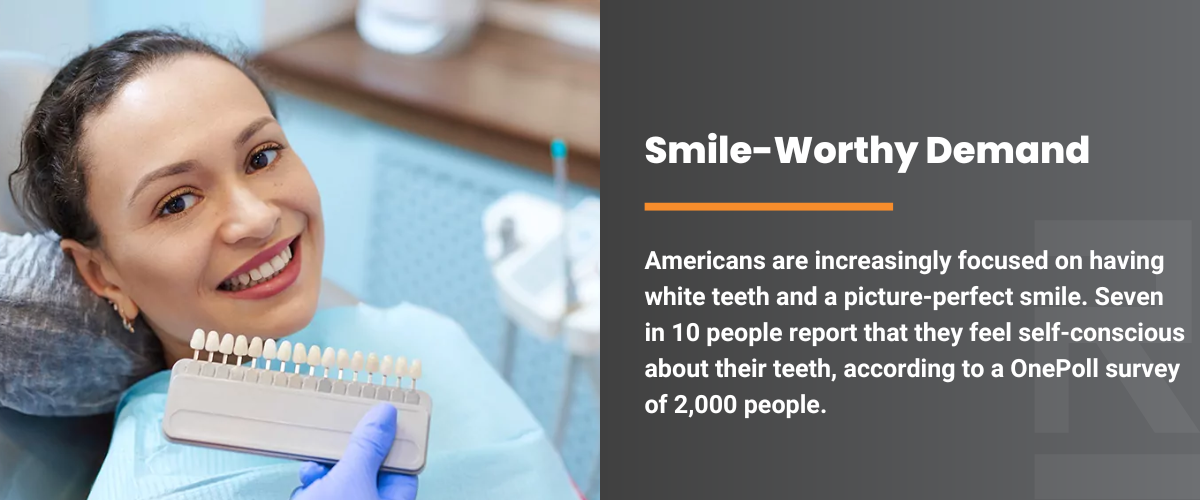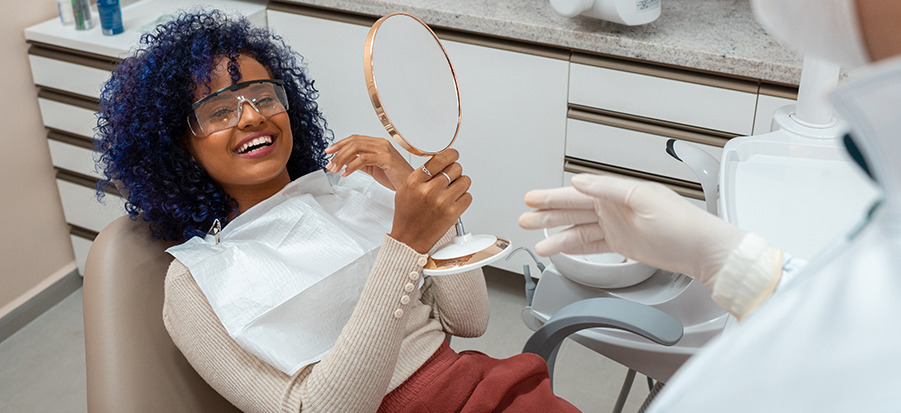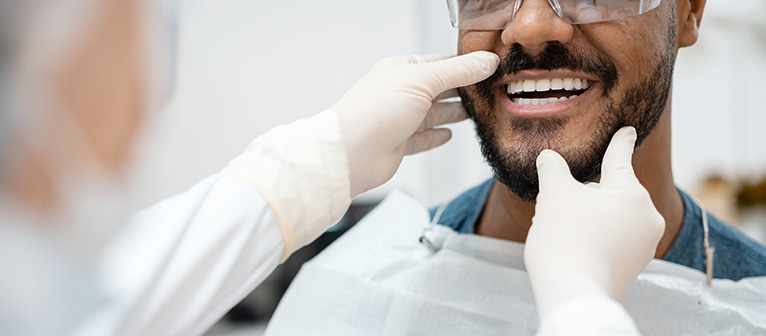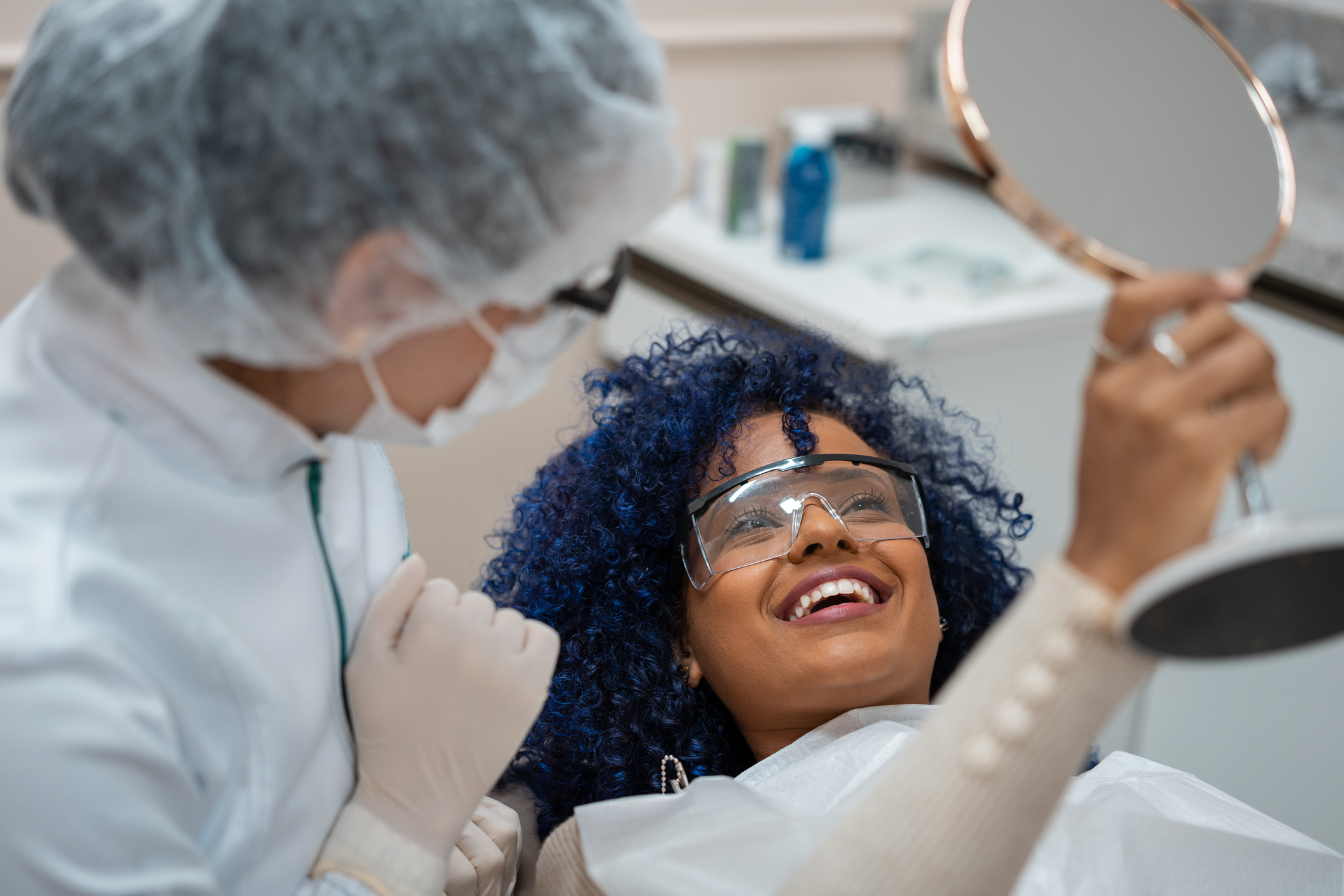Cosmetic dentistry can be a bright spot for patients and practices alike. While individuals gain confidence from a winning smile, cosmetic dental practices celebrate the high patient satisfaction and loyalty such work provides. The pandemic has done little to depress current and future demand for cosmetic dentistry. In fact, the global market is expected to grow 6.6% annually, reaching $30.1 billion1 by 2025, according to research firm Markets & Markets. And the American Academy of Cosmetic Dentistry found that in the United States alone, annual spend on cosmetic dentistry is at $2.75 billion. Patients in their thirties are the largest segment inquiring about cosmetic dentistry procedures, but interest spans almost every generation.
Masks and mandates may have shifted the focus away from elective procedures, but as social restrictions ease and vaccination rates rise, people are once again focused on their smiles. Some cosmetic dental practices have seen nearly a 50% increase2 in requests for teeth whitening so far in 2021, NBC reports. As one chief clinical officer of a cosmetic dental practice put it, “When [people] start to reveal themselves and go back into the social environment, the value of a smile is just incredible.” High demand and a broad potential patient base should make cosmetic dentistry unstoppable for most practices. However the issue of payments can be a huge hurdle—both for patients, who aren’t clear on their options, and practices, which may struggle to capture patient payments. Flexible, convenient payment options can help remove those hurdles, so patients are able to get the cosmetic procedures they so clearly want, and cosmetic dental practices can experience a revenue lift without over-taxing their front office.

Smile-Worthy Demand
Americans are increasingly focused on having white teeth and a picture-perfect smile. Seven in 10 people report that they feel self-conscious about their teeth, according to a OnePoll survey3 of 2,000 people. The survey also found that 57% of Americans cover their mouths when they laugh due to insecurities about their teeth, and one in four have received a negative comment about their teeth from a significant other or coworker. Nearly two-thirds of Americans wish they could change something about their teeth. In order, the most sought-after cosmetic dentistry options are teeth-whitening, crookedness, receding gums, and spaces between teeth.
One might assume that the mask-wearing might have suppressed the desire for white, even teeth, but instead the opposite seems to be true. For those knowledge workers who spent much of the pandemic looking at their own images during videoconferencing calls, any seeds of desire for self-improvement have only bloomed. And for anyone separated from friends and family for a lengthy lockdown, the desire to reconnect socially is matched by an instinct to look their best and prioritize self-care. The frenzy for a more perfect smile even made it to TikTok, the social media platform particularly popular with Gen Z. The Washington Post reports4 that teens are posting TikTok videos of themselves going to extreme and even dangerous measures, to change their appearance.
Surging demand for cosmetic dentistry has made patients more willing to pay. The average patient spent $4,336 on cosmetic dentistry in 2019, according to the latest Cosmetic Dentistry: State of the Industry5 report. Additionally 10% of practices reported that their patients spent more than $10,000 each. Direct bonding was by far the most popular cosmetic procedure, followed by crown and bridge work, and then implant procedures. Since cosmetic dentistry often isn’t covered by health insurance, this means patients who might be accustomed to having everything from their annual physicals to their optometry appointments run through insurance are now left to navigate payment options on their own. Even those individuals with access to disposable income may not understand which payment methods are available or appropriate to use.
For practices that are well-versed in handling non-cosmetic payments through insurance channels, there are also barriers getting in the way of increased demand. Educating patients about cosmetic dentistry financing might be new terrain, or the cosmetic dental practice might fear the front-office burden that comes with juggling manual credit card payments or chasing bill reminders. Armed with the right tools, though, cosmetic dental practices have an opportunity to both meet the influx in demand and put patient uncertainty at ease. Cosmetic dental practices that can provide clear guidance and offer flexible payment options may find that their patients are even more satisfied and have higher loyalty than those who are left to muddle through on their own.
The Payment Landscape
While many cosmetic dentistry procedures may not be covered by traditional insurance, patients do have several options for payment. Here’s an overview of the most common financing methods available to patients, along with the pluses and minuses for practitioners:
Traditional Credit Cards
Leveraging a traditional credit card can be an effective way for patients to maximize credit rewards programs or spread payments over longer time periods. If they’re able to get access to a card with an introductory zero percent APR, they might even avoid making interest payments on the balance. Still, if patients aren’t able to pay off their balance before the billing cycle is over or the introductory period ends, the interest rate on any remaining balance can be a heavy burden. And because many people make only minimum payments on their credit card statements, it’s possible those high interest rates will affect many patients.
Key Takeaway:
Relying on credit cards can be somewhat fraught for patients. It may help out in a pinch, but combining healthcare bills and credit may lead to difficulty paying down the balance. If that happens, patients may find themselves dealing with even more debt.
Healthcare Credit Cards
Cosmetic dentistry is included as an authorized category by most major healthcare credit cards, which function very similarly to traditional credit cards. CareCredit6, for instance, is a credit card accepted by more than 240,000 healthcare providers to finance out-of-pocket medical and dental costs from enrolled providers. Healthcare credit cards tend to offer patients a generous interest-free window within which to make payments, typically ranging from six to 24 months, depending on the credit worthiness of the cardholder. After that window, the interest fees can be above average.
Key Takeaway:
When a patient opts to use a healthcare credit card, the cosmetic dental practice is typically paid in full in as little as two days. It’s important to understand, though, that in order to accept payment from a healthcare credit card, the dental practice often has to be part of an existing network and have a standing contract in place with the card issuer.
Special Healthcare Funding Accounts
As healthcare costs rise, patients may find they have more options than ever to creatively save in designated accounts with lower tax burdens. Using these funds to cover healthcare expenses effectively gives them a discount on the procedure (as they’re using pre-tax or lower-taxed dollars), without dampening the practice’s margin. Typically, there must be a proven, health-related need for the procedure.
Key Takeaway:
The patient may have access to Health Savings Accounts (HSAs), Flexible Spending Accounts (FSAs), and Healthcare Reimbursement Accounts (HRAs). But there are often limitations on how those funded accounts can be used for cosmetic procedures, and there are frequent7 updates to the regulations governing FSAs and HSAs, which can make it tough to stay up to date on accurately advising your patients. If a patient needs restorative work that could be done in a cosmetic manner, these types of accounts may be an option.
Cash or Credit?
Those are hardly the only options that patients might encounter when trying to finance their cosmetic dental procedures. Armed with the right tools, cosmetic dental practices have an opportunity to both meet demand and put patient financial uncertainty at ease.
In-House Financing Programs
Offering payment plans can help put cosmetic dentistry procedures within reach for more patients. Practices might offer to spread the cost of the cosmetic dental procedure over six, 12, or 18 months, with possible discount incentives if the patient is able to complete payments more quickly. Because the cosmetic dental practice creates its own policies around an in-house financing program, it can be shaped to suit the practice. You might require a sizable deposit upfront, for instance, or extend the payment window based on the credit worthiness of the patient. Still,
implementing such a program can be a time-intensive administrative burden, as the practice’s staff will be responsible for tracking and processing scheduled payments, sending payment reminders, and crafting follow-up communications.
Key Takeaway:
With in-house financing, the practice shoulders the risk of future nonpayment. Practices can set up automatic installment payments with a signed pre-authorization form to help ensure patient
payment. If a practice is unable to process the payment method, the balance of the procedure can be turned over to a collection agency to pursue future payments. But collection agencies typically take a fee to 30% to 50%8of the account balance, according to the California Dental Association.
Third-Party Financing Programs
With an outsourced financing solution, the patient signs a legal financing agreement and may be charged interest, while an intermediary administers the program on behalf of the cosmetic dental practice and keeps the program up to date on all legal and regulatory compliance issues. While the cosmetic dental practice isn’t paid entirely upfront, it does earn interest, dramatically slashing its risk of nonpayment for the procedure. Additionally, communications about late payments or missed payments come from the third party rather than directly from the practice. Therefore, these payment communications allow the cosmetic dental practice to preserve the best patient-dentist relationship and sidestep some of the uncomfortable money conversations.
Key Takeaway:
There is some risk that a patient may fall behind on making payments, but that can be minimized by being selective about which patients are offered this type of financing option and by adjusting the interest rates and program fees to help offset potential losses. Note that not all patients will be approved to receive third-party financing, so it’s important to train front office staff to not offer it as a given. Patients can be reminded that financial options may be available to them and encourage them to apply. If a patient’s application is declined for the full treatment fee, an option is for practices to try and gain approval for a lesser dollar amount and ask the patient to pay the remaining fee with a different payment method.

Solving the Payment Predicament
Offering various financing options helps patients get the cosmetic dental procedures they want—while managing the practice’s risk and lowering its administrative burden. However, when a practice is already juggling multiple insurance payers, government-sponsored programs, and cash-only patients, any new program needs to be turnkey and comprehensive.
Rectangle Health’s Practice Management Bridge® was developed exclusively for healthcare and is ideal for cosmetic dentistry. It meets your patients where they are—whether they want to pay online through their mobile device or in person with a mobile wallet, spread their payments over multiple months, or securely store credit card information for future procedures. The Practice Management Bridge platform isn’t designed for only one type of patient or procedure, but for all patients and for whatever care they need.
When it comes to payment options, practices who utilize Rectangle Health’s Practice Management Bridge platform are able to offer their patients:
- Contactless payments, using Apple Pay®, Google Pay™, Samsung Pay®, and other touch-free payments. Contactless payment had been growing in popularity among younger Americans over the past few years, but COVID-19 and heightened awareness of surface germs have accelerated its adoption. According to a survey by Payments Journal, there’s been a 30% increase9 in the use of contactless payments since the start of the pandemic. As more patients come to expect a contactless payment option, cosmetic dental practices who are able to offer this avenue may find increased satisfaction.
- Text-to-Pay, with secure text message links. Gone are the days when patients want to be reached by a phone call or postal mail—and pursuing payments in that way can be resource-intensive for cosmetic dental practices. Instead, Practice Management Bridge allows practices to automatically reach patients where their attention is already focused—on their phones. With a few quick clicks, patients can follow through on making payments in a secure, convenient manner.
- Store card on file, to use their preferred payment method for future charges without having to swipe a card at checkout or re-enter credit card or bank
information. This is the frictionless experience that patients have come to expect in the consumer environment, such as with online shopping. And those expectations are slowly becoming the norm even in non-retail settings, such as healthcare. Patients don’t want to confront the hassle of checking out with a physical card or re-entering sensitive information time after time. Storing a patient’s card on file removes that inconvenience, while making it easier for them to follow through on payments in a timely manner and increasing the likelihood that they will complete payment. - Opt for flexible payment plans, so large out-of-pocket expenses become more manageable for patients. Flexible payment plans in our dental practice management software offer simple, custom payment options for patients who aren’t able to or interested in making full payments at the time of the procedure. For many patients, being able to opt for interest-free payment plans can make the difference between choosing to pursue care or not. Payment plans are set up to charge the patient’s preferred payment method automatically on a monthly or weekly schedule to save the office time and effort from manual processing. The flexibility of payment plans allows dental practices to receive more incoming patients and accrue consistent incoming payments while more patients are able to move forward with receiving the care they need.
The Upside of Options
Payment confusion shouldn’t get in the way of receiving care—and that’s as true for cosmetic dentistry as it is for any other type of procedure. When patients feel confident that there will be a financing option that fits their needs and preferences, they’re more likely to move forward with the procedure, but that’s not the only upside. Offering convenient, secure, easy-to-navigate payment tools can also increase patient satisfaction with the front-office experience and may even yield more patient referrals and long-lasting loyalty. One recent SuperOffice survey10 found that—more than price or product—people award their loyalty based on the experience they receive. In fact, 86% of buyers are willing to pay more for a great customer experience. With Rectangle Health’s Practice Management Bridge platform, cosmetic dental practices can make the payments process part of a preferred patient experience.
Questions to Consider
1. How will this work with our existing software?
Many cosmetic dental practices are already juggling multiple systems, from electronic health records to scheduling software to patient communication portals. Adding a payment platform only makes sense if it can interface seamlessly with the existing practice management software. An ideal payment platform would be able to easily post payments to the patient ledger in your practice management system, integrate with patient registration forms, and pull updates from the patient’s EHR. Finding a payments platform specifically tailored to the unique needs of the healthcare industry can help solve those integration issues with ease.
2. How frictionless is the financing solution?
Requiring every patient to upload their banking details or to re-enter their credit card information each time they want to make a payment isn’t only a hassle but also, adverse to today’s expectations. Each point of friction becomes an opportunity for the patient to put off the task—delaying payment for the dental practice. For payments to be truly frictionless, they must also be flexible: allowing patients to use Text-to-Pay, offering them contactless payments, or storing their debit or credit card on file for easy access on future charges.
3. What does patient communication look like?
Here’s a sobering statistic: Nearly one-quarter11 of self-described loyal patients would change healthcare providers if offered better communications tools by a competitor. Unfortunately, many dental practices are still relying on voice messages and mailers to reach patients about upcoming appointments or missed payments. Relying on these communication tools is not only out of
BRIGHTENING SMILES AND GROWING REVENUE 11 step with how most patients want to be reached, it’s a huge resource drain on the practice. Instead, look for a communications tool that’s customizable and reaches patients where they are—already starting at their phones. Message sends shouldn’t only be available for payment reminders and links to make online payments, but also for appointment reminders, appointment openings, and links to fill out digital registration forms ahead of time. The more that patients can see the value in a practice’s messaging, the more responsive—and loyal—they may be.
4. What about security?
Data security is a top concern for patients and providers alike. Practices should take steps to protect themselves from potential breaches and to instill trust in their patients. Put patients at ease by choosing a platform that offers top-of-the-industry encryption and robust security for both online payments and payment information shared with your office, so they feel comfortable not only entering their details once but storing them for easier access later.
5. What will this mean for the practice’s profitability?
Implementation of healthcare technology is meant to buoy the practice’s bottom line—either by freeing up staff to focus on revenue-generating activities or by moving the needle on payments captured. The right payment platform should be able to do both, automating front-office workflows and
optimizing the billing and payment process.
Conclusion
To sustain a healthy business, a cosmetic dental practice needs to attract new patients, while collecting payments from current ones. Having the right financing platform in place can help on both fronts, by attracting patients who seek flexible financing options and by making the payments process fast, convenient, and frictionless—so more patients follow through. While the pandemic has dramatically increased demand for cosmetic dentistry, practices must stay mindful that patients who typically rely on insurance coverage may be navigating new waters when it comes to figuring out financing with this type of care. A turnkey financing platform makes it easy to meet patients where they’re at, with the type of financing option that fits their needs and preferences, without placing more burden on the practice’s front-office staff. That’s a win-win for patients and cosmetic dental practices alike.



